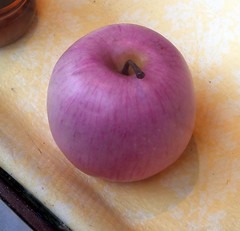September 17, 2010
Apples and oranges
 The fact that the concept apples and oranges has a wikipedia page is at first glance amusing. But comparing apples and oranges does have a pretty big literature. I noticed it because I was looking up references in this field for a serious publication (honest!)
The fact that the concept apples and oranges has a wikipedia page is at first glance amusing. But comparing apples and oranges does have a pretty big literature. I noticed it because I was looking up references in this field for a serious publication (honest!)
The classic is Scott Sandford, “Apples and oranges – a comparison”, Annals of Improbable Research, vol. 1: 3, 1995. This one contains a comparison of their spectra, clearly showing they can be compared.
James E Barone, “Comparing apples and oranges: a randomised prospective study”, British Medical Journal, 321:1569, December 2000, which (besides doing comparisions) found an increasing number of literature citations and pointed out that, given the similarities, it would be better to say “Let's not compare walnuts with elephants” or “Let's not compare tumour necrosis factor with linguini.” rather thank "Let's not compare apples and oranges."
This appears to be a pretty well cited article. Including letters to the editor pointing out Sandford's paper. It was cited by Zsuzsa Kaldy, Erik Blaser, How to Compare Apples and Oranges: Infants' Object Identification Tested With Equally Salient Shape, Luminance and Color Changes, Infancy. 2009 March; 14(2): 222–243. which demonstrates that infants probably could compare apples and oranges. Or at least see the difference.
Generally, there has been a lot of criticism of the idiom along the same lines as above: the objects should be more incompatible. Rabbi Johnathon Kroll suggests "milk and roller coasters", Alon Krausz, suggests "milk and running" or "milk and the fourth dimension", Eugene Volkh suggested "apples and democracy" or "oranges and the multiplication table", while someone [citation needed] suggests "to compare research and 39".
Of course, to make things truly incomensurable it has to be something like "apples and ![]() ".
".